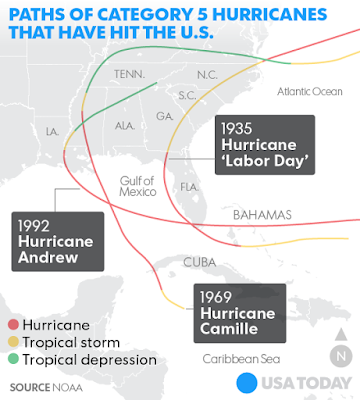The most dangerous of these immense tropical storms are those classified as "CAT 5" meaning they contain winds in excess of 157 mph. Those winds produce catastrophic damage to structures on land, and produce tremendous storm surges which add to their destructive power. The 1935 category 5 hurricane was unnamed, referred to as the 'Labor Day' hurricane, it struck the Florida Keys with sustained 185 mph winds. It is the strongest hurricane to make landfall on record. The storm killed 423 people including veterans living in tents while building a road in the islands. So powerful, its 15 feet storm surge swept people out to sea off the low-lying keys, and knocked a relief train off the rails.
Although it was the strongest, it was not the deadliest. That dubious honor goes to another anonymous hurricane that flattened Galveston, TX killing an estimated six to eight thousand people in 1900. Hurricane Allen in 1980 produced winds of an astonishing 190 mph, but did not make landfall as a category 5; its amazing winds were exceed by a Pacific cyclone, Patricia, that clocked winds at 215 mph! The categorization of hurricane power by wind speed (Saffir-Simpson scale) alone is somewhat misleading. The amount of rainfall associated with the storm also contributes to damage. Katrina, which came ashore as a category 3, was considered the costliest storm in US history after it flooded the city of New Orleans causing $108 billion in damage and killing 1200 people. Harvey now holds that record of costliest.
Hurricane Irma's distinct eye--one of the strongest storms ever in the Atlantic

